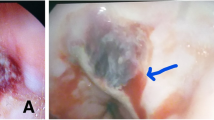Abstract
Background
Acute bleeding from nontreated esophageal varices is associated with a mortality rate of 30% to 50%. Various pharmacologic and interventional methods to stop acute bleeding are available. However, for 10% to 20% of patients, therapy fails to stop the bleeding. This study aimed to assess the SX-ELLA Stent Danis Set (which has a self-expanding metal stent) instead of a balloon probe for compression of esophageal varices.
Methods
Using a multidisciplinary approach, a self-expanding stent was placed in 39 patients between January 2003 and August 2007. For 34 of these patients with ongoing bleeding from esophageal varices, stent implantation was performed with the SX-ELLA Stent Danis Set, and the patients were included in this study. For all these patients, common methods failed to stop hemorrhage. With the SX-ELLA Stent Danis Set, the stent was implanted with a positioning balloon that enabled delivery without X-ray control. After implantation of the stent, its position was controlled by endoscopy and computed tomography (CT) scan.
Results
For all 34 patients, the implantation of the esophageal stent succeeded in stopping ongoing bleeding. No stent-related complications occurred during or after stent implantation. No bleeding recurrence was observed during the stent implantation (median time, 5 days; range 1–14 days). For all the patients, the stent could be extracted by endoscopy without any complications using an extractor. Nine patients died of hepatic failure within 30 days after the procedure. No rebleeding occurred.
Conclusions
The use of a self-expanding stent to stop acute bleeding from esophageal varices is a new therapeutic method. The authors’ initial experience, which involved no method-related mortality or complications, is encouraging. More data are necessary to confirm their results.


Similar content being viewed by others
References
Stokkeland K, Brandt L, Ekbom A, Hultcrantz R (2006) Improved prognosis for patients hospitalized with esophageal varices in Sweden 1969–2002. Hepatology 43:500–505
D'Amico G, Pagliaro L, Bosch J (1995) The treatment of portal hypertension: a meta-analytic review. Hepatology 22:332–354
Hubmann R, Bodlaj G, Czompo M, Benko L, Pichler P, Al-Kathib S, Kiblbock P, Shamyieh A, Biesenbach G (2006) The use of self-expanding metal stents to treat acute esophageal variceal bleeding. Endoscopy 38:896–901
Karsan HA, Morton SC, Shekelle PG, Spiegel BM, Suttorp MJ, Edelstein MA, Gralnek IM (2005) Combination endoscopic band ligation and sclerotherapy compared with endoscopic band ligation alone for the secondary prophylaxis of esophageal variceal hemorrhage: a meta-analysis. Dig Dis Sci 50:399–406
D’Amico G, Pietrosi G, Tarantino I, Pagliaro L (2003) Emergency sclerotherapy versus vasoactive drugs for variceal bleeding in cirrhosis: a Cochrane meta-analysis. Gastroenterology 124:1277–1291
Garcia-Pagan JC, Bosch J (2005) Endoscopic band ligation in the treatment of portal hypertension. Nat Clin Pract Gastroenterol Hepatol 2:526–535
Svoboda P, Kantorova I, Ochmann J, Kozumplik L, Marsova J (1999) A prospective randomized controlled trial of sclerotherapy vs ligation in the prophylactic treatment of high-risk esophageal varices. Surg Endosc 13:580–584
Baroncini D, Milandri GL, Borioni D, Piemontese A, Cennamo V, Billi P, Dal Monte PP, D’Imperio N (1997) A prospective randomized trial of sclerotherapy versus ligation in the elective treatment of bleeding esophageal varices. Endoscopy 29:235–240
Masci E, Stigliano R, Mariani A, Bertoni G, Baroncini D, Cennamo V, Micheletti G, Casetti T, Tansini P, Buscarini E, Ranzato R, Norberto L (1999) Prospective multicenter randomized trial comparing banding ligation with sclerotherapy of esophageal varices. Hepatogastroenterology 46:1769–1773
Lo GH, Chen WC, Chen MH, Hsu PI, Lin CK, Tsai WL, Lai KH (2002) Banding ligation versus nadolol and isosorbide mononitrate for the prevention of esophageal variceal rebleeding. Gastroenterology 123:728–734
Sarin SK, Wadhawan M, Gupta R, Shahi H (2005) Evaluation of endoscopic variceal ligation (EVL) versus propanolol plus isosorbide mononitrate/nadolol (ISMN) in the prevention of variceal rebleeding: comparison of cirrhotic and noncirrhotic patients. Dig Dis Sci 50:1538–1547
de Franchis R (2005) Evolving consensus in portal hypertension: report of the Baveno IV consensus workshop on methodology of diagnosis and therapy in portal hypertension. J Hepatol 43:167–176
Zhang CQ, Liu FL, Liang B, Sun ZQ, Xu HW, Xu L, Feng K, Liu ZC (2007) A modified percutaneous transhepatic variceal embolization with 2-octyl cyanoacrylate versus endoscopic ligation in esophageal variceal bleeding management: randomized controlled trial. Dig Dis Sci [Epub ahead of print]
Harewood GC, Baron TH, Song LM (2006) Factors predicting success of endoscopic variceal ligation for secondary prophylaxis of esophageal variceal bleeding. J Gastroenterol Hepatol 21(1 Pt 2):237–241
Lo GH, Liang HL, Chen WC, Chen MH, Lai KH, Hsu PI, Lin CK, Chan HH, Pan HB (2007) A prospective, randomized controlled trial of transjugular intrahepatic portosystemic shunt versus cyanoacrylate injection in the prevention of gastric variceal rebleeding. Endoscopy 39:679–685
Sorbi D, Gostout CJ, Peura D, Johnson D, Lanza F, Foutch PG, Schleck CD, Zinsmeister AR (2003) An assessment of the management of acute bleeding varices: a multicenter prospective member-based study. Am J Gastroenterol 98:2424–2434
Dormann A, Meisner S, Verin N, Wenk Lang A (2004) Self-expanding metal stents for gastroduodenal malignancies: systematic review of their clinical effectiveness. Endoscopy 36:543–550
Danis J, Hubmann R, Pichler P, Shamiyeh A, Wayand WU (2004) Novel technique of laparoscopic azygoportal disconnection for treatment of esophageal varicosis: preliminary experience with five patients. Surg Endosc 18:702–705
Cook D, Laine L (1992) Indications, technique, and complications of balloon tamponade for variceal gastrointestinal bleeding. J Intensive Care Med 7:212–218
Avgerinos A, Armonis A (1994) Balloon tamponade technique and efficacy in variceal haemorrhage. Scand J Gastroenterol Suppl 207:11–16
Author information
Authors and Affiliations
Corresponding author
Rights and permissions
About this article
Cite this article
Zehetner, J., Shamiyeh, A., Wayand, W. et al. Results of a new method to stop acute bleeding from esophageal varices: implantation of a self-expanding stent. Surg Endosc 22, 2149–2152 (2008). https://doi.org/10.1007/s00464-008-0009-7
Received:
Revised:
Accepted:
Published:
Issue Date:
DOI: https://doi.org/10.1007/s00464-008-0009-7




